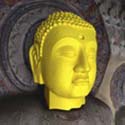|
|
| Show All 35 Results (Text Only) |
|
|
| Bronze Age Casting |
|
| National Museum of Asian Art, Smithsonian Institution
|
|
The ability to make bronze tools, weapons, and ritual vessels was such a significant advancement in world civilization that it lends its name to an entire era: the Bronze Age. The skill and resources needed to fabricate bronze were in place in ancient China by 1700 BCE, over a thousand years later than in Egypt, Mesopotamia, and India. The earliest Chinese bronze artifacts have been traced to the Erlitou culture in Henan province. Their discovery confirms foundries for smelting and casting metal were active in northern China between 1300 and 900 BCE, a highpoint of early Chinese casting.
Making bronze requires two things: copper and tin ores, sometimes mixed with lead; and intense heat for refining and casting. Chinese founders made their metal objects using clay for both models and removable section molds. (This differs from the Mediterranean and European practice of casting objects using wax-covered models.)
Go to Museum Resource: https://asia.si.edu/learn/ancient-chinese-bronzes/bronze-age-casting/ | |
|
|
| Buddhist Cave Temple Sculpture |
|
| Victoria and Albert Museum
|
The Central Asian tradition of building such complexes was been practiced for centuries, primarily with Imperial sponsorship in the Northern regions, where Buddhism first took hold. The very act of creating these vast monuments, hollowed out from rock faces and decorated so lavishly within, was considered an act of 'piety' resulting in the accrual of merit, which in Buddhism is accumulated as a result of good deeds, acts or thoughts. This merit is then carried over to later in life or to a person's next birth. The sculptures and paintings also functioned as an important focus for worship and as symbolic links between the worldly and heavenly realms. People would have travelled great distances to see them and to worship and make offerings before them.
Go to Museum Resource: http://www.vam.ac.uk/content/articles/c/chinese-buddhist-cave-temple-sculpture/ | |
|
|
| The Buddhist Cave Temples of Xiangtangshan |
|
| New York University, Institute for the Study of the Ancient World
|
Carved into the side of a mountain, the Buddhist cave temples at Xiangtangshan (“Shahng-tahng-shahn”) are the crowning cultural achievement of the short-lived Northern Qi (“Chee”) dynasty, which ruled over most of northeastern China from 550 to 577 ce. The name Xiangtangshan translates as “Mountain of Echoing Halls,” and refers to two groups of rock-cut shrines in Hebei province close to ancient Ye, the Northern Qi capital. The emperors and courtiers who commissioned the temples were non-Chinese, of mixed ethnicities from north of the Great Wall, and practiced Buddhism, a religion favored by this elite. In their entirety, these cave temples housed an awe-inspiring world below ground and reflect a long tradition, begun in India, of situating holy places within the earth itself. Includes 12 over life-size sculptures from this Buddhist cave temple complex with a full-scale, digital, 3-D reconstruction of the interior of one of the site’s impressive caves.
Go to Museum Resource: http://isaw.nyu.edu/exhibitions/echoes | |
|
|
| Buddhist Sculpture from China |
|
| China Institute
|
“The period covered by Buddhist Sculpture from China fits within Era 4 of the National History Standards, “Expanding Zones of Exchange and Encounter, 300-1000 CE”: Buddhist, Christian, and Hindu Traditions: Not only Islam but other major religions also spread widely during this 700-year era. Wherever these faiths were introduced, they carried with them a variety of cultural traditions, aesthetic ideas, and ways of organizing human endeavor. Each of them also embraced peoples of all classes and diverse languages in common worship and moral commitment….The entry of Buddhism into China and East Asia at the beginning of the Common Era is central to any perception of cultural exchange as playing “a crucial role in human history, being perhaps the most important external stimuli to change, leaving aside military conquest” (Curtin 1984: 1).”
Go to Museum Resource: https://china360online.org/?property=buddhist-sculpture-from-china | |
|
|
| Cave as Canvas: Hidden Images of Worship Along the Ancient Silk Routes |
|
| National Museum of Asian Art, Smithsonian Institution
|
Buddhist Cave Temples in Chinese Central Asia. Buddhism reached Chinese Central Asia (modern Xinjiang) from India around the first century A.D., brought by missionaries via the ancient Silk Routes. By the third century A.D., this new religion was flourishing in all the oasis kingdoms in the Tarim Basin (the Taklamakan Desert), also known as eastern Turkestan. As the Buddhist religion took hold and piety increased, the Indian tradition of excavating caves to serve as Buddhist sanctuaries proliferated in this region. In many of the Central Asian states, monasteries and temples were hewn out of the cliffs in secluded river valleys. With the patronage of local rulers, the elite, and wealthy merchants, these institutions gradually became major Buddhist centers. They continued to grow and prosper until the advent of Islam. Today, such Buddhist rock-cut cave complexes are some of the finest, if little known, monuments preserved in Chinese Central Asia.
Go to Museum Resource: https://archive.asia.si.edu/exhibitions/online/cave/default.htm | |
|
|
| China: Dawn of a Golden Age, 200–750 AD |
|
| The Metropolitan Museum of Art
|
Publication of the exhibit that explores exceptional works of art from forty-six institutions in the People's Republic of China. Includes references to works of art in the Metropolitan's permanent collection, relevant literary references, maps, and details about how certain objects were crafted. See also exhibition publication.
Go to Museum Resource: https://www.metmuseum.org/exhibitions/listings/2004/china-dawn-of-a-golden-age | |
|
|
|
|
| Show All 35 Results (Text Only) |









